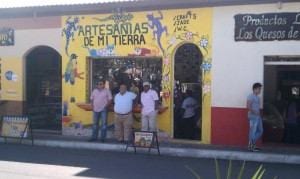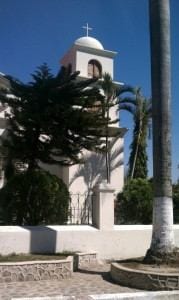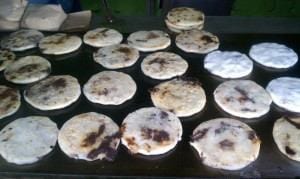Travel Tips
El Salvador: Five Days in ‘The 30-Minute Country’
Day Four: La Ruta de las Flores
If you want to get a sense of non-city life in El Salvador, the beautiful Ruta de las Flores takes you through some of the country’s picturesque villages. Each of the villages along the way is known for a specific skill. You’ll want to start in Ataco, which is known for its beautiful murals. Though it’s technically at the end of the route, it’s worth going there simply for the lovely inn there, Casa de Mamapan, which features big, sunny rooms and art books on bedside tables. The famous murals in Ataco began, like almost everything these days, with some paintings of cats.
 Luckily, most of the murals are in a small area of several blocks, meaning you can see almost everything in a short amount of time. From there, you can continue on to the rest of the Flower Route. Highlights include Nahuizalco, which is known for its handicrafts (you can get everything from toys to wicker furniture to handmade blankets at shops along the side of the road and in the main square), El Carmen Estates (home to a coffee plantation and a beautiful old guest house), and Apaneca (the highest town in El Salvador, it’s great for outdoor activities like camping, hiking, biking, and even paragliding).
Luckily, most of the murals are in a small area of several blocks, meaning you can see almost everything in a short amount of time. From there, you can continue on to the rest of the Flower Route. Highlights include Nahuizalco, which is known for its handicrafts (you can get everything from toys to wicker furniture to handmade blankets at shops along the side of the road and in the main square), El Carmen Estates (home to a coffee plantation and a beautiful old guest house), and Apaneca (the highest town in El Salvador, it’s great for outdoor activities like camping, hiking, biking, and even paragliding).
Day Five Anigo Cuscatlan and Santa Tecla
 Though the village of Antiguo Cuzcatlan is technically part of El Salvador, the village has retained its history and personality after being swallowed up by the capitol. It retains a small-town feel, with a woman on the corner hacking into coconuts to make juice and local kids in school uniforms running past on their lunch breaks. The highlight of Antiguo Cuzcatlan is its beautiful main square and church, known simply as the Parish Church, but it’s also home to the pretty Botanical Gardens, which are a good place to spend a hot Salvadorean afternoon. The eco-hotel Arbol de Fuego (Tree of Fire) is centrally located within walking distance of everything in Antiguo Cuscatlan, and it also boasts gorgeous greenery, the ability to make its own power, and female ownership (which is extremely rare in Central America).
Though the village of Antiguo Cuzcatlan is technically part of El Salvador, the village has retained its history and personality after being swallowed up by the capitol. It retains a small-town feel, with a woman on the corner hacking into coconuts to make juice and local kids in school uniforms running past on their lunch breaks. The highlight of Antiguo Cuzcatlan is its beautiful main square and church, known simply as the Parish Church, but it’s also home to the pretty Botanical Gardens, which are a good place to spend a hot Salvadorean afternoon. The eco-hotel Arbol de Fuego (Tree of Fire) is centrally located within walking distance of everything in Antiguo Cuscatlan, and it also boasts gorgeous greenery, the ability to make its own power, and female ownership (which is extremely rare in Central America).
For a lunch like the locals do it, head to Pupuseria La Unica. It’s almost impossible to visit El Salvador without sampling the national dish, the pupusa. The thick, doughy tortillas are filled with everything from cheese to beans to mashed garlic and pork, and any pupuseria worth visiting will make your meal to order. The neighborhood of Antiguo Cuzcatlan used to be a village but was swallowed by the ever-expanding capital. Besides a beautiful church and bustling local square, it’s also home to a stretch of road overflowing with pupuserias. La Unica is the one to beat, though. You’ll see everyone from infants to grandmas plopping down at one of the orange tables and chowing down here, and once you try a pupusa or five you’ll understand why. Get a local Pilsener beer to finish off the meal.
 If you want to see what true Salvadorean nightlife is like, take a 20-minute drive out to Santa Tecla. Thanks to a new mayor who wants to revitalize the town, Santa Tecla is now the coolest place in the country. The main drag is Paseo de Carmen, a long strip of pedestrian-only walkway that features chic cafes, bars, and shops. A quick walk around the center of town will pretty accurately sum up all of El Salvador and its approach to tourism: the bones are there, but the exterior needs a little bit of freshening up. If you love places off the beaten path, where you’re likely to be the only turista in sight, go now before El Salvador becomes the next cool destination.
If you want to see what true Salvadorean nightlife is like, take a 20-minute drive out to Santa Tecla. Thanks to a new mayor who wants to revitalize the town, Santa Tecla is now the coolest place in the country. The main drag is Paseo de Carmen, a long strip of pedestrian-only walkway that features chic cafes, bars, and shops. A quick walk around the center of town will pretty accurately sum up all of El Salvador and its approach to tourism: the bones are there, but the exterior needs a little bit of freshening up. If you love places off the beaten path, where you’re likely to be the only turista in sight, go now before El Salvador becomes the next cool destination.
Text and Photos by Lilit Marcus for PeterGreenberg.com. Lilit is a freelance writer who lives in Manhattan and tries to get out of it as much as possible. Her work has also appeared in Glamour, The Daily, and Jaunted.com. Follow her on Twitter at @lilitmarcus.












